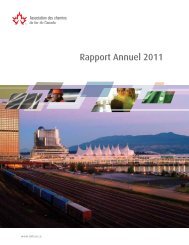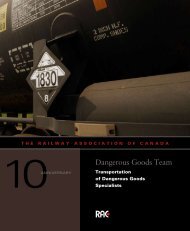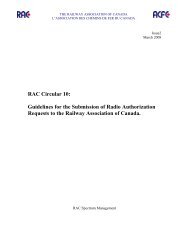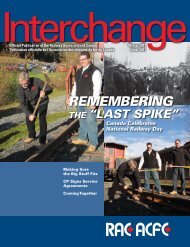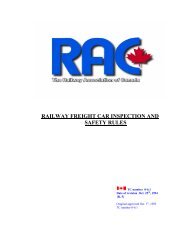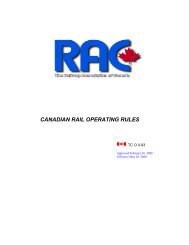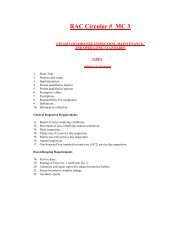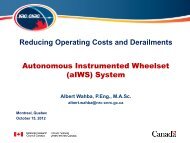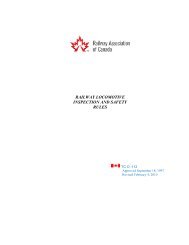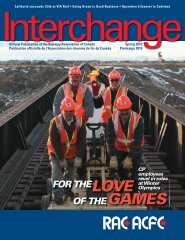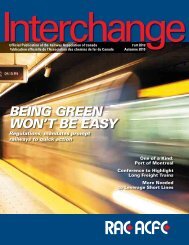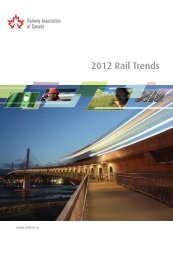Locomotive Emissions Monitoring Program - Railway Association of ...
Locomotive Emissions Monitoring Program - Railway Association of ...
Locomotive Emissions Monitoring Program - Railway Association of ...
Create successful ePaper yourself
Turn your PDF publications into a flip-book with our unique Google optimized e-Paper software.
7.2.10<br />
Intercity Passenger Train Equipment Initiatives<br />
<strong>Emissions</strong> reduction initiatives underway or planned for VIA Rail Canada’s intercity operations include locomotive<br />
low-idle settings, upgrading the engines <strong>of</strong> FP40 units to make them more fuel efficient, installing separate headend<br />
power (HEP) low-emissions diesel generators in FP40s and promoting the use <strong>of</strong> dynamic braking. Similarly,<br />
under test and evaluation on a P42 locomotive are Layover Heat and AESS systems. The use <strong>of</strong> 15 ppm ultra-low<br />
sulphur fuel (ULSF) has been standardized for VIA’s operations. Not only does ULSF reduce SOx emissions but also<br />
sulphur-based PM formed during diesel combustion.<br />
Initiatives to reduce coach energy requirements (which result in a lower power draw from the HEP, hence<br />
lower emissions generated) include installation <strong>of</strong> light-emitting diode (LED) and low-mercury fluorescent tube<br />
lighting, lowering air conditioning demand by raising the set point and weight reduction by removal <strong>of</strong> redundant<br />
electrical equipment.<br />
7.2.11<br />
Passenger Train Layover Systems<br />
Commuter and intercity passenger railways shut down locomotives during layover, such as overnight and during <strong>of</strong>fpeak<br />
periods. To maintain suitable passenger comfort levels when the locomotive is shut down, wayside electrical<br />
power for coach heating or cooling is drawn from the local utility. As well, locomotive layover heating systems have<br />
been installed that keep the engine coolant and crankcase oil warm and the batteries charged. This allows the engines<br />
to be shut down anytime during the year, resulting in significant fuel savings and reductions <strong>of</strong> emissions and noise.<br />
7.2.12<br />
Commuter Rail Equipment Modifications<br />
The GO Transit coach fleet is being retr<strong>of</strong>itted with reflective windows which reduce solar gain significantly, thus reducing<br />
air conditioning requirements in summer. To further reduce energy loss, new and refurbished coaches are being fitted with<br />
upgraded insulation and LED lighting (to replace incandescent lighting). GO Transit has also retr<strong>of</strong>itted the locomotives<br />
with an energy management switch which reduces the heating and cooling requirements <strong>of</strong> the coaches when the train is<br />
not in revenue service but not on wayside power and, therefore, does not require full heating or cooling.<br />
All commuter railways have standardized on ultra-low sulphur diesel fuel. West Coast Express is working with<br />
Environment Canada to test and evaluate on two <strong>of</strong> its locomotives diesel exhaust oxidation catalyst after-treatment<br />
devices, for which use <strong>of</strong> ultra-low sulphur diesel fuel is necessary for their functioning.<br />
7.2.13<br />
Fuel Additives<br />
The supply sector <strong>of</strong>fers additives to diesel fuel that claim to improve combustion and reduce emissions. The railways<br />
undertake on-going assessments and testing in this regard to determine whether the claimed improvements are<br />
applicable for railway operations, whether there are potential negative effects and if opting for the additive would be<br />
cost-effective and operationally feasible. For example, GO Transit uses the proprietary FPC fuel additive and reported<br />
advantages for fuel consumption. The advantages were confirmed in tests at Engine Systems Development Centre <strong>of</strong> CAD<br />
<strong>Railway</strong> Industries in Lachine, Quebec, which showed a 2.5 to 7.0 per cent reduction (depending on notch and load) with<br />
concomitant reductions in CO and smoke emissions <strong>of</strong> 2.8 to 5.8 per cent, but a slight increase in NOx emissions 21 . 10<br />
7.2.14<br />
Alternate Fuels<br />
Interest in alternatives to diesel No.2 fuel stems from general concern about GHG emissions and the long-term<br />
availability <strong>of</strong> petroleum-based diesel No.2 fuel. A candidate alternate fuel is biodiesel produced from agricultural<br />
feedstock whose life-cycle CO 2 is significantly lower than standard diesel fuel emissions. The Southern <strong>Railway</strong> <strong>of</strong><br />
British Columbia initiated in 2008 an operational evaluation <strong>of</strong> biodiesel to fuel its locomotives.<br />
21 Evaluation <strong>of</strong> Performance <strong>of</strong> FPC Fuel Additive in an EMD F59PH <strong>Locomotive</strong>, Report No. ETR-0260 prepared for GO Transit by Engine Systems<br />
Development Centre Inc., Lachine, Quebec – February 2003<br />
30 LEM 2008





